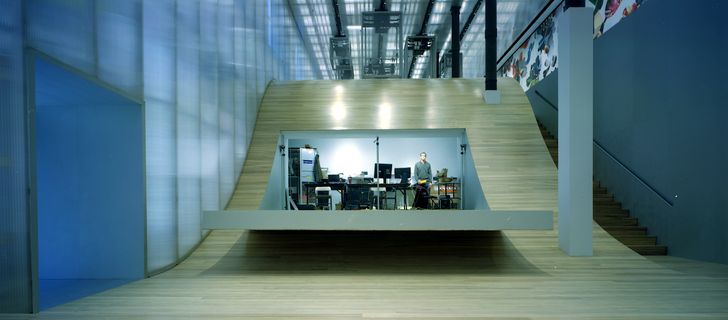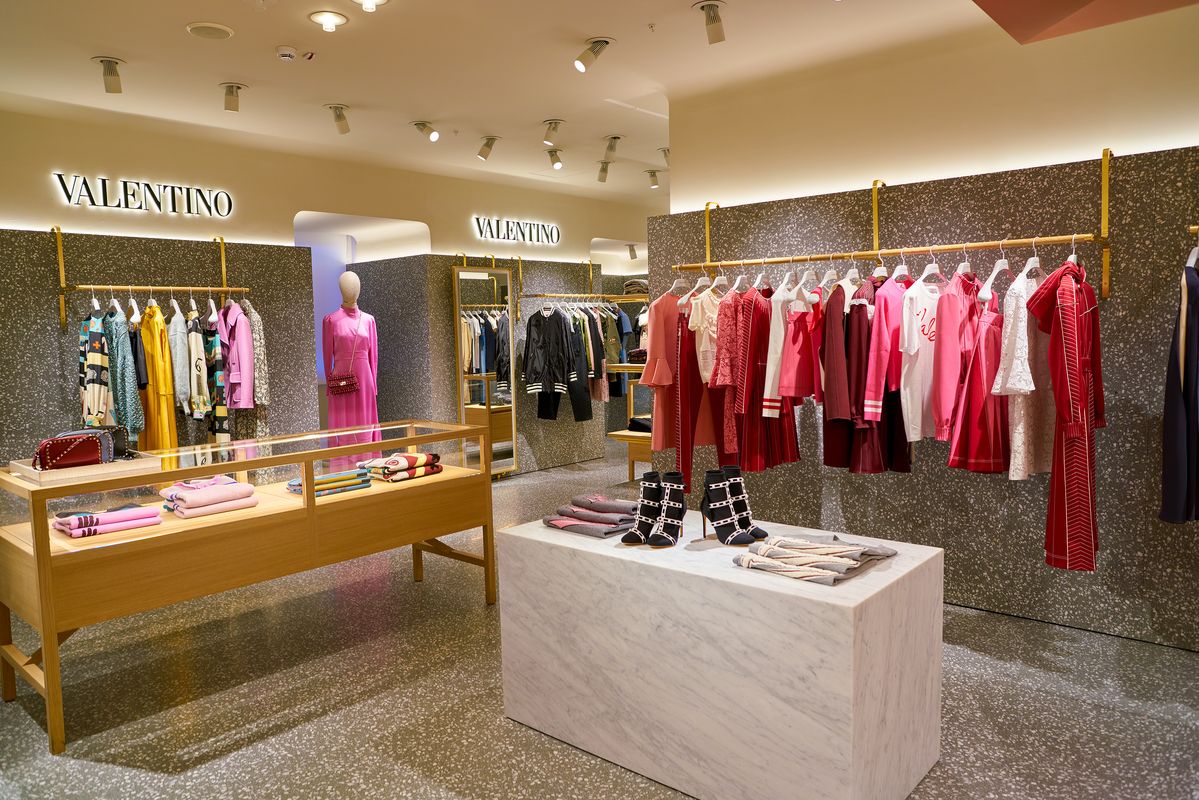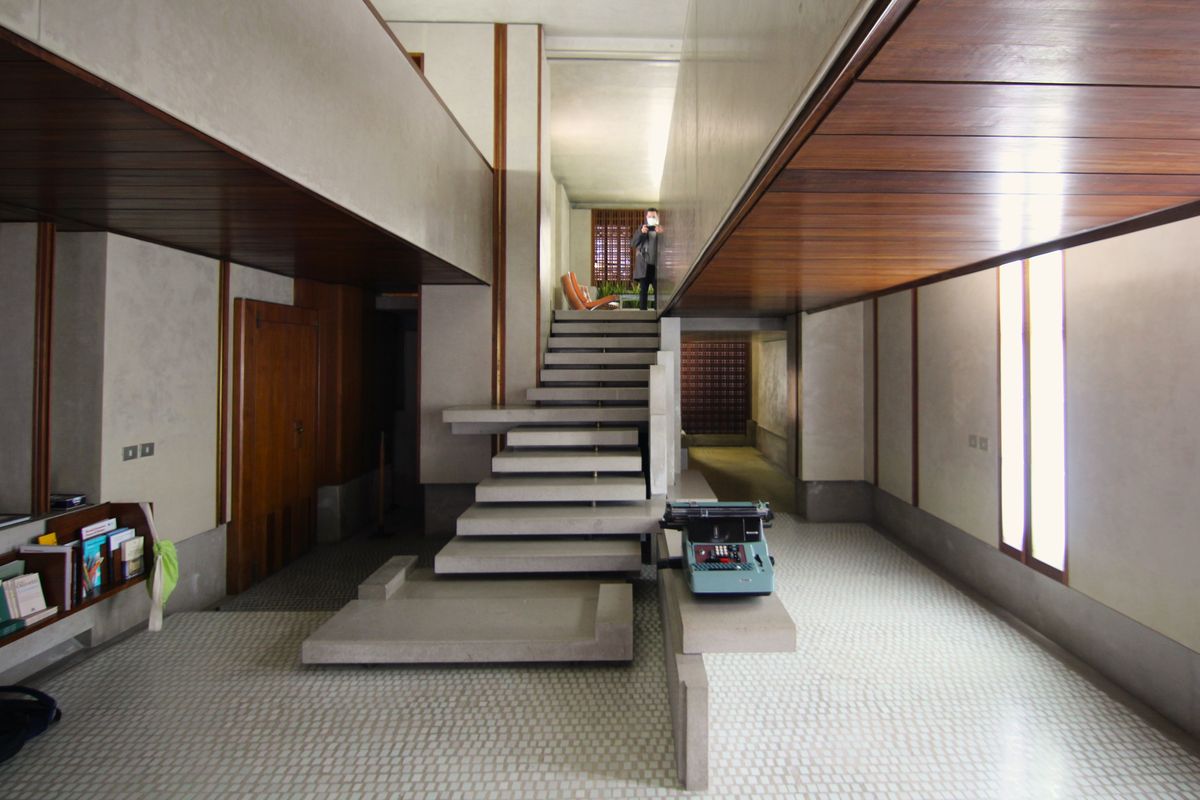To Ryan Russell, co-founder and director of the acclaimed architecture and design firm Russell and George, innovative interior retail design is about creating a dialogue with the customer. It’s about curating an experience and crafting a narrative.
In an era where convenience is omnipresent, interior retail design has had to evolve beyond just creating a space for physical product display to creating an environment that provides opportunities for engagement, immersion, absorption and reflection.
Russell’s five retail interiors in the world all follow this theme. They are all experiential, prophetic, timeless, dynamic and they all incorporate elements that he says, “gets people off their couches” and into the store. All five projects have left a lasting mark on Russell, shaping and influencing the way he thinks about design.
New York Prada Epicenter, New York
The main feature of the New York Prada Epicenter by OMA / AMO is the wave, which a stage can unfold from.
Image: Armin Linke
“Transformative,” was the word Russell used to describe the New York Prada Epicenter in SoHo, designed by OMA / AMO. He went to visit the boutique multipurpose space in the early 2000s, shortly after it was opened.
The main feature of the space is a curve, dubbed “the wave,” which slopes from the ground floor and leads to the basement. On one side of the wave, steps can be used for the display of shoes and accessories, adjacent to that are more stairs that can be used as a seating area. A stage can unfold from the wave, allowing the space to convert into a venue for performances, talks or screenings.
Russell said epicenter designers pioneered the model for a semi-public, semi-private retail space, a model that many stores have since adopted. He continues to be impressed by OMA / AMO’s ability to present unique and innovative display methods, through the use of display stairs and floating cages in void areas. “The design is still very relevant today. It’s continued to evolve and change but all within that same or similar framework that was set up there,” he said.
Valentino Flagship Store, Rome
Valentino Flagship Store by David Chipperfield.
Image: Santi Caleca
“Luxury is about restraint and good taste, and I think that is certainly evident in David Chipperfield’s design for this store. It was a big shift for Valentino to move away from a more traditional interior to this minimalist, effortless style that really allows the garments to pop,” Russell said.
Venetian terrazzo and marble feature throughout the store, creating a purposefully understated backdrop. Russell admires the way the design incorporates subtle details and a muted palette to highlight the collection pieces and make them the focal point of the store.
Each room within the multi-level boutique is distinctive from one another, with each space designed to complement the pieces it houses. “It’s just a lovely composition of spaces to wander through. It’s timeless and the model just allows for the products to really shine,” Russell said.
Olivetti Showroom, Venice
Olivetti Showroom by Carlo Scarpa, 1957-1958.
Image: Unsplash/Rui Alves
Most in the field of architecture are familiar with the Olivetti Showroom designed by Carlo Scarpa, and so it may not come as a surprise that Russell has nominated the space as one of his top five retail interiors.
Adriano Olivetti commissioned Scarpa to design a display space for his typewriters in 1957. Born in 1958, the Olivetti Showroom, now a museum, continues to be appreciated for its exquisite attention to detail. Featuring irregularly shaped hand cut mosaic floor tiles and an asymmetrical concrete staircase, it is the carefully curated materials that make this space a true classic.
Russell admires what he calls “the typewriter aesthetic,” the way in which the Olivetti brand and the theme of typewriters has been carefully considered and blended into the design. “It’s just got this tactile quality that resonates with typewriters. It’s beautifully detailed.”
Le Bon Marche, Paris
Le Bon Marche by Louis-Charles Boileau and Gustav Eiffel.
Image: Laurence/Adobe Stock
The world’s oldest department store, Le Bon Marche manages to harmoniously tie in its historical narrative while still delivering something that is contemporary, relevant and fresh – something that Russell said is harder to achieve than it sounds. “It’s historic and progressive at the same time, which is very difficult to do.”
Designed by Louis-Charles Boileau and Gustav Eiffel in the 1800s, it is the evolution and the resilience of the building that fascinates Russell. “It’s had its ups and downs throughout history, it’s expanded, it was damaged by fire, and it’s been reconstructed,” he said.
“The interior design has always incorporated this kind of artistic bent and there are always major artists that exhibit in the central atrium, kind of riffing off the interior. It’s always been a beautiful store that just continues to evolve and every time I’ve gone back, there’s always been something new and interesting that has been incorporated.”
“Good retail is always thought-provoking, it’s an experience and it’s not just about selling products. It’s about engaging with the customer and that’s something Le Bon Marche has managed to do every time I’ve been there.”
Il Micio, Florence
A small, intimate and understated bespoke leather shoe store in Florence has captured Russell’s heart. Il Micio opened in the early 2000s, and while it was not designed by an architect, the beauty of the store lies in the journey that it takes you on.
“The moment you walk in, you can see this wonderful artisan, this shoemaker at work,” he said. “He takes you on a journey and that journey can actually lead to repeat journeys.”
“Retail is about creating a dialogue with your customer and when you’ve got someone who is so talented at their work, they effectively become a part of the shopping experience.”
Russell said it’s the simplicity of the store that speaks volumes and provides a very personal shopping experience. “Some of the best-designed retail stores are created by non-designers. The store has this lovely paired back aesthetic that gives customers a glimpse into the shoemaker’s workshop at the back.”




























